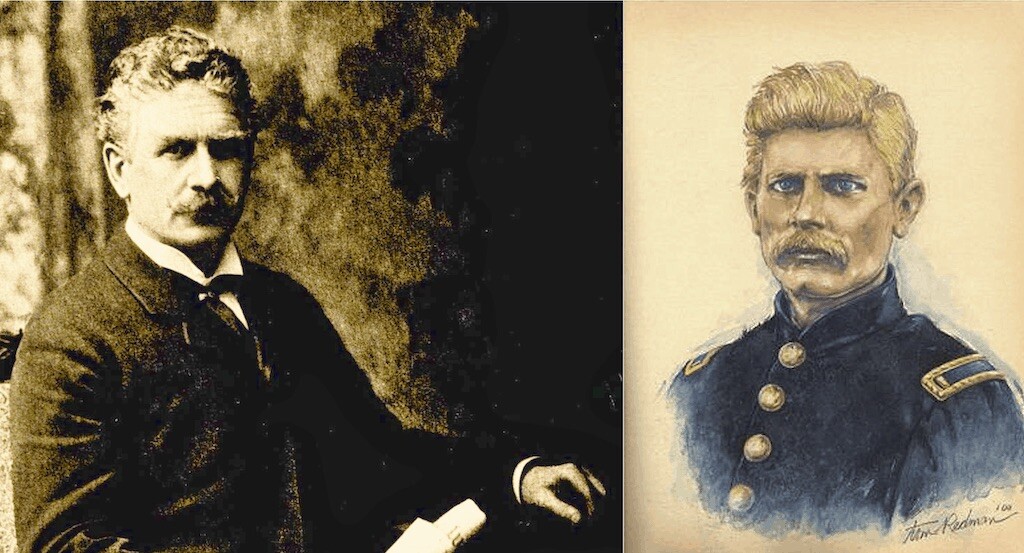Writer Ambrose Bierce lived a colorful life. He had served as a soldier in the Civil War, worked as a columnist, and became a famous author. In 1913, with 71 years of age, he embarked on an adventure to Mexico to cover the Mexican Revolution presumably for a story and possibly to interview Pancho Villa. Although he left behind a slew of great literature, it is the swarm of mysteries and theories that surrounded Ambrose Bierce’s death which has truly shaped his legacy.

The disappearance of the famous author Ambrose Bierce remains a mystery. (L) Public Domain. (R) CC3.0 Tom Redman. Compilation by Historic Mysteries.
Short Biography of Ambrose Bierce
Born in Ohio in 1842, Ambrose was the 10th of 13 children. All of them, for some reason known only to the parents, had names beginning with the first letter of the alphabet. His brothers and sisters were Abigail, Amelia, Ann, Addison, Aurelius, Augustus, Almeda, Andrew, Albert, Arthur, Adelia, and Aurelia.
During the American Civil War, Bierce joined the Union Army’s 9th Indiana Infantry Regiment and served in several key battles. His travels and service in the military would serve as a basis for some of his subsequent works of literature.
After the War, he found himself in San Francisco and used his nascent writing talents to support himself and his family. He had married in 1871 and fathered three children. Ambrose moved his brood to England for three years in the 1870s and then returned to San Francisco to continue his writing career.
That career was prolific. In addition to his newspaper journalism work, Bierce wrote short stories and horror fiction books that were highly praised. Arguably his most famous short story is An Occurrence at Owl Creek Bridge, but he also wrote poetry and such lauded books as The Devil’s Dictionary and The Cynic’s Word Book.
The David Lang Disappearance Story
By late 1913, Bierce was divorced and free to pursue a wandering writer’s life. So, at the age of 71, he embarked on a trip to visit famous battle sites of the Civil War. After this journey, his whereabouts and fate become murky and lead to the many infamous theories about his death.
Off to Mexico
The prevalent theory states that he crossed into Mexico from Texas on horseback. Mexico was in the midst of their own civil war, and the country was a dangerous one to be in. Still, the exact reason for his trip there is unknown. Clearly, he was aware of the danger in the war-torn country. At the time, he wrote a foreboding note to a relative:
[blockquote align=”none” author=”Ambrose Bierce”]Goodbye. If you hear of my being stood up against a Mexican stone wall and shot to rags please know that I think that a pretty good way to depart this life. It beats old age, disease, or falling down the cellar stairs. I shall not be here long enough to hear from you, and don’t know where I shall be next.[/blockquote]
Ambrose was never heard from again. His daughter initiated an investigation, but no conclusive trace of Bierce’s last days ever turned up.
Theories on Bierce’s Disappearance
Theories surfaced over time, some more bizarre than others. While some scholars and historians believe that factions of the armies in Mexico indeed killed Bierce, others believe that he killed himself and used his alleged presence in Mexico as a cover for this self-destructive act.
One story says Bierce sustained serious wounds at the battle in Ojinaga. He made it to the border and into the States, but he died without identification or any papers in Camp Marfa. Other witnesses say he actually died in the battle. He body was burned along with all the others. Another says he was riding a mule train with Federales when Pancho Villa’s men overran the train and killed him. (Gander 2014).
Even stranger and straight out of an Indiana Jones movie, another tale states that Bierce and cohorts stole a Mayan artifact, “the Skull of Doom,” but died in the attempt to return to the USA with their treasure. In his early 70s at this time, it is somewhat hard to picture Bierce in such an effort of daring adventure. Yet another farfetched theory details an explorer who came across native people who worshipped as a god an old man wrapped in jaguar skins.
The only fact about Bierce’s end is that there is no fact. Whatever happened to Ambrose Bierce, at this late date, is likely to remain a mystery. Fortunately, Bierce’s legacy lives on beyond his mysterious end by the strength and popularity of the writings he left behind.
References:
Gander, Forrest. “Very Trustworthy Witnesses.” The Paris Review. October 27, 2014.
“Top 10 Famous Disappearances.” Time. October 03, 2008. Accessed July 27, 2019.